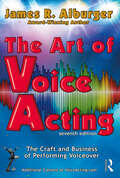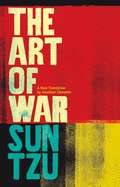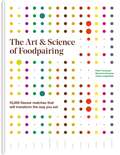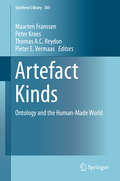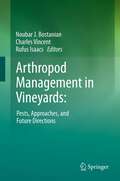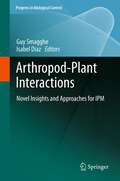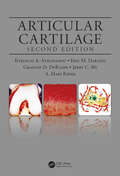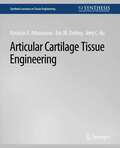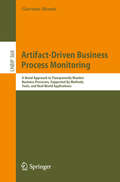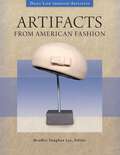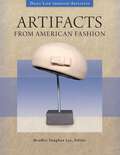- Table View
- List View
The Art of Voice Acting: The Craft and Business of Performing for Voiceover
by James R. AlburgerNow in its seventh edition, The Art of Voice Acting covers all aspects of the craft and business of performing voiceover. Starting with the basics of voice acting, every aspect of the craft and business of performing voiceover is explained in detail, including how to get started, performing techniques, setting up a personal recording space, voiceover demos, the basics of running a voiceover business, unions and much, much more. This edition is completely updated with all new scripts, discussions of the latest trends in voiceover and contributions from some of the voiceover industry’s top performers, casting directors and agents. The book provides a wealth of practical information that can be put to work immediately, as well as hundreds of references to websites and other useful resources. Anyone interested in acting, storytelling, any area of voiceover or simply improving verbal communication skills will benefit from this book. Although The Art of Voice Acting is a great learning tool for the beginner, it will also serve the experienced performer well as a reminder of performing and business tools that are essential in today’s world of acting and voiceover. Additional content, including scripts, audio files, and unpublished content can be found at www.AOVA.VoiceActing.com.
The Art of War: A New Translation (Penguin Modern Classics Ser. #909)
by Jonathan ClementsA new translation for the 21st century.The Art of War by Sun Tzu is one of the most influential political and business books of our era. This gateway edition for the 21st century reader rediscovers the essential clarity of the ancient masterpiece, cited by generals from a dozen Chinese dynasties, international business leaders, and modern military field manuals.This edition also contains a full commentary on Sun Tzu, the man and his ideas, contemporary of Confucius and Buddha; and a critical guide to further reading. This is the perfect introduction to one of the world's best-known classics.
The Art of War for Computer Security
by Tom MadsenIn this book the author draws inspiration from Sun Tzu's Art of War, a work that explains conflict between nations, and he applies this to the computer security setting, examining how we should consider protecting information systems from accidents or malicious attacks. The author first briefly introduces Sun Tzu. Then each chapter in the book takes its inspiration from an original title in The Art of War, where the author offers a general introduction to the content and then describes its application in a cybersecurity setting. These chapters cover estimates; waging war; offensive strategy; how you prepare for an attack; energy; weaknesses and strengths; the variables that need consideration before embarking on a war; how infrastructure is related to the concept of ground; attack by fire or how skilled attackers hide behind noise; and employing secret agents. The book will be interesting for computer security researchers and professionals who would like some grounding in a security mindset.
The Art of Wireless Sensor Networks: Volume 1: Fundamentals (Signals and Communication Technology)
by Habib M. AmmariDuring the last one and a half decades, wireless sensor networks have witnessed significant growth and tremendous development in both academia and industry. “The Art of Wireless Sensor Networks: Volume 1: Fundamentals” focuses on the fundamentals concepts in the design, analysis, and implementation of wireless sensor networks. It covers the various layers of the lifecycle of this type of network from the physical layer up to the application layer. Its rationale is that the first volume covers contemporary design issues, tools, and protocols for radio-based two-dimensional terrestrial sensor networks. All the book chapters in this volume include up-to-date research work spanning various classic facets of the physical properties and functional behavior of wireless sensor networks, including physical layer, medium access control, data routing, topology management, mobility management, localization, task management, data management, data gathering, security, middleware, sensor technology, standards, and operating systems. This book will be an excellent source of information for both senior undergraduate and graduate students majoring in computer science, computer engineering, electrical engineering, or any related discipline. In addition, computer scientists, researchers, and practitioners in both academia and industry will find this book useful and interesting.
The Art of Wireless Sensor Networks: Volume 2: Advanced Topics and Applications (Signals and Communication Technology)
by Habib M. AmmariDuring the last one and a half decades, wireless sensor networks have witnessed significant growth and tremendous development in both academia and industry. A large number of researchers, including computer scientists and engineers, have been interested in solving challenging problems that span all the layers of the protocol stack of sensor networking systems. Several venues, such as journals, conferences, and workshops, have been launched to cover innovative research and practice in this promising and rapidly advancing field. Because of these trends, I thought it would be beneficial to provide our sensor networks community with a comprehensive reference on as much of the findings as possible on a variety of topics in wireless sensor networks. As this area of research is in continuous progress, it does not seem to be a reasonable solution to keep delaying the publication of such reference any more.This book relates to the second volume and focuses on the advanced topics and applications of wireless sensor networks. Our rationale is that the second volume has all application-specific and non-conventional sensor networks, emerging techniques and advanced topics that are not as matured as what is covered in the first volume. Thus, the second volume deals with three-dimensional, underground, underwater, body-mounted, and societal networks. Following Donald E. Knuth’s above-quoted elegant strategy to focus on several important fields (The Art of Computer Programming: Fundamental Algorithms, 1997), all the book chapters in this volume include up-to-date research work spanning various topics, such as stochastic modeling, barrier and spatiotemporal coverage, tracking, estimation, counting, coverage and localization in three-dimensional sensor networks, topology control and routing in three-dimensional sensor networks, underground and underwater sensor networks, multimedia and body sensor networks, and social sensing. Most of these major topics can be covered in an advanced course on wireless sensor networks. This book will be an excellent source of information for graduate students majoring in computer science, computer engineering, electrical engineering, or any related discipline. Furthermore, computer scientists, researchers, and practitioners in both academia and industry will find this book useful and interesting.
The Art of Writing Reasonable Organic Reaction Mechanisms
by Robert B. GrossmanIntended for students of intermediate organic chemistry, this text shows how to write a reasonable mechanism for an organic chemical transformation. The discussion is organized by types of mechanisms and the conditions under which the reaction is executed, rather than by the overall reaction as is the case in most textbooks. Each chapter discusses common mechanistic pathways and suggests practical tips for drawing them. Worked problems are included in the discussion of each mechanism, and "common error alerts" are scattered throughout the text to warn readers about pitfalls and misconceptions that bedevil students. Each chapter is capped by a large problem set.
The Art of Writing Reasonable Organic Reaction Mechanisms
by Robert B. GrossmanIntended for students of intermediate organic chemistry, this text shows how to write a reasonable mechanism for an organic chemical transformation. The discussion is organized by types of mechanisms and the conditions under which the reaction is executed, rather than by the overall reaction as is the case in most textbooks. Each chapter discusses common mechanistic pathways and suggests practical tips for drawing them. Worked problems are included in the discussion of each mechanism, and "common error alerts" are scattered throughout the text to warn readers about pitfalls and misconceptions that bedevil students. Each chapter is capped by a large problem set.
The Art & Science of Foodpairing: 10,000 Flavour Matches That Will Transform The Way You Eat
by Peter Coucquyt Bernard Lahousse Johan Langenbick"We build tools to create culinary happiness" - Foodpairing.com "There is a world of exciting flavour combinations out there and when they work it's incredibly exciting" - Heston BlumenthalFoodpairing is a method for identifying which foods go well together, based on groundbreaking scientific research that combines neurogastronomy (how the brain perceives flavour) with the analysis of aroma profiles derived from the chemical components of food.This groundbreaking new book explains why the food combinations we know and love work so well together (strawberries + chocolate, for example) and opens up a whole new world of delicious pairings (strawberries + parmesan, say) that will transform the way we eat. With ten times more pairings than any other book on flavour, plus the science behind flavours explained, Foodpairing will become THE go-to reference for flavour and an instant classic for anyone interested in how to eat well.Contributors:Astrid Gutsche and Gaston Acurio - Astrid y Gaston - PeruAndoni Luiz Aduriz - Mugaritz - SpainHeston Blumenthal - The Fat Duck - UKTony Conigliaro - DrinksFactory - UKSang Hoon Degeimbre - L'Air du Temps - BelgiumJason Howard - #50YearsBim - UK/CaribbeanMingoo Kang - Mingles - KoreaJane Lopes & Ben Shewry - Attica - AustraliaVirgilio Martinez - Central - PeruDominique Persoone - The Chocolate Line - BelgiumKarlos Ponte - Taller - Venezuela/DenmarkJoan Roce - El Celler de Can Roca - SpainDan Barber - Blue Hill at Stone Barns - USAKobus van der Merwe - Wolfgat - South AfricaDarren Purchese - Burch & Purchese Sweet Studio - MelbourneAlex Atala - D.O.M - BrazilMaría José San Román - Monastrell - SpainKeiko Nagae - Arôme conseil en patisserie - Paris
Artefact Kinds: Ontology and the Human-Made World (Synthese Library #365)
by Maarten Franssen Peter Kroes Thomas A.C. Reydon Pieter E. VermaasThis book is concerned with two intimately related topics of metaphysics: the identity of entities and the foundations of classification. What it adds to previous discussions of these topics is that it addresses them with respect to human-made entities, that is, artefacts. As the chapters in the book show, questions of identity and classification require other treatments and lead to other answers for artefacts than for natural entities. These answers are of interest to philosophers not only for their clarification of artefacts as a category of things but also for the new light they may shed on these issue with respect to to natural entities. This volume is structured in three parts. The contributions in Part I address basic ontological and metaphysical questions in relation to artefact kinds: How should we conceive of artefact kinds? Are they real kinds? How are identity conditions for artefacts and artefact kinds related? The contributions in Part II address meta-ontological questions: What, exactly, should an ontological account of artefact kinds provide us with? What scope can it aim for? Which ways of approaching the ontology of artefact kinds are there, how promising are they, and how should we assess this? In Part III, the essays offer engineering practice rather than theoretical philosophy as a point of reference. The issues addressed here include: How do engineers classify technical artefacts and on what grounds? What makes specific classes of technical artefacts candidates for ontologically real kinds, and by which criteria?
The Artemis Lunar Program: Returning People to the Moon (Springer Praxis Books)
by Manfred “Dutch” von EhrenfriedThis book describes the future of the Artemis Lunar Program from the years 2017 to about 2030. Despite the uncertainty of the times and the present state of space exploration, it is likely that what is presented in this book will actually happen, to one degree or another. As history has taught us, predictions are often difficult, but one can see enough into the future to be somewhat accurate. As the Bible says, “Wesee thru the glass, but darkly.”All of the elements of the proposed program are described from several perspectives: NASA’s, the commercial space industry and our International partners. Also included are descriptions of the many vehicles, habitats, landers, payloads and experiments. The book tells the story of the buildup of a very small space station in a strange new lunar orbit and the descent of payloads and humans, including the first women and next man, to the lunar surface with the intent to evolve a sustained presence over time.
Artful Design: Technology in Search of the Sublime, A MusiComic Manifesto
by Ge WangWhat we make, makes us. This is the central tenet of Artful Design, a photorealistic comic book that examines the nature, purpose, and meaning of design. A call to action and a meditation on art, authenticity, and social connection in a world disrupted by technological change, this book articulates a fundamental principle for design: that we should design not just from practical needs but from the values that underlie those needs. Artful Design takes readers on a journey through the aesthetic dimensions of technology. Using music as a universal phenomenon that has evolved alongside technology, this book breaks down concrete case studies in computer-mediated toys, tools, games, and instruments, including the best-selling app Ocarina. Every chapter elaborates a set of general design principles and strategies that illuminate the essential relationship between aesthetics and engineering, art and design. Ge Wang implores us to both embrace and confront technology, not purely as a means to an end, but in its potential to enrich life. Technology is never a neutral agent, but through what we do with it—through what we design with it—it provides a mirror to our human endeavors and values. Artful Design delivers an aesthetic manifesto of technology, accessible yet uncompromising.
Arthritis: Pathophysiology, Prevention, and Therapeutics
by Debasis Bagchi Hiroyoshi Moriyama Siba P. RaychaudhuriA debilitating disease of pain, inflammation, and loss of mobility and quality of life, arthritis takes victims of all ages, from young children to seniors. Usually chronic, the broad term arthritis refers to nearly 100 distinct manifestations, each with their own etiology, pathophysiology, and treatment. With medical research getting so much atten
Arthropod Management and Landscape Considerations in Large-Scale Agroecosystems
by Matthew O'Neal Steven E. Naranjo Ian MacRae Kristopher L Giles Tom Royer Peter C Ellsworth Kristen Baum Mahendra Bhandari Haley Butler Hannalene Du Plessis Norman C. Elliott Sarah Elzay Isaac L. Esquivel Ashleigh M. Faris Aaron J. Gassmann Maura Hall Louis S. Hesler Anders S. Huseth William D. Hutchison Robert L. Meagher Jr Lance J. Meinke Shannon L. Osborne Pankaj Pal Katherine A. Parys Dominic Reisig Nina Rudin Thomas W. Sappington Gregory A. Sword Ashley E. Tessnow Paul A. Umina Johnnie Van BergFor large-scale agroecosystems, patterns of pest population increases (graded increases or abrupt outbreaks) and declines (graded suppression or abrupt crashes) vary considerably and are influenced by factors within crop fields and across broader landscape scales. Better understanding of pest population dynamics and the implications of spatial interactions on the function and development of pest management approaches are the main themes of this important book. The book builds from a 60+ year history of field-based pest management by focusing on the drivers of pest management in large-scale agroecosystems and the landscape-scale processes that affect these drivers and contribute to variation in pest outbreaks and suppression. These drivers include abiotic and biotic influences such as weather, spatial composition and arrangement of landscape elements, and widely applied managed inputs such as planting and crop rotation schedules, crop varietal selection, and land and soil conservation efforts. The book introduces general concepts, opportunities, and challenges of arthropod management in large-scale agroecosystems. Case studies from major field crop-based agroecosystems are used to present research approaches and improve understanding and management of pest and beneficial insects in large-scale agroecosystems. Specific research findings are provided on multi-trophic interactions within the system as influenced by climate, landscape, and other ecological, agricultural, and social/economic components of the agroecosystem. The book concludes with a synthesis of these concepts and prospectus for future research and developments in arthropod management in large-scale, plant-based agroecosystems. The book is essential reading for researchers in applied entomology and ecology and for pest management practitioners.
Arthropod Management in Vineyards: Pests, Approaches, and Future Directions
by Noubar J. Bostanian, Charles Vincent and Rufus IsaacsProvides a state-of-the-science overview of arthropods affecting grape production around the world. Vineyard pest management is a dynamic and evolving field, and the contributed chapters provide insights into arthropods that limit this important crop and its products. Written by international experts from the major grape-growing regions, it provides a global overview of arthropods affecting vines and the novel strategies being used to prevent economic losses, including invasive pests affecting viticulture. The book contains reviews of the theoretical basis of integrated pest management, multiple chapters on biological control, current status of chemical control, as well as in-depth and well-illustrated reviews of the major arthropod pests affecting grape production and how they are being managed worldwide. This text will serve as a primary resource for applied entomologists, students, growers, and consultants with interests at the intersection of viticulture and applied entomology.
Arthropod-Plant Interactions: Novel Insights and Approaches for IPM (Progress in Biological Control #14)
by Guy Smagghe and Isabel DiazThe book consists of multiple chapters by leading experts on the different aspects in the unique relationship between arthropods and plants, the underlying mechanisms, realized successes and failures of interactions and application for IPM, and future lines of research and perspectives. Interesting is the availability of the current genomes of different insects, mites and nematodes and different important plants and agricultural crops to bring better insights in the cross talk mechanisms and interacting players. This book will be the first one that integrates all this fascinating and newest (from the last 5 years) information from different leading research laboratories in the world and with perspectives from academia, government and industry.
Articular Cartilage
by Kyriacos A. Athanasiou Eric M. Darling Jerry C. Hu Grayson D. DuRaine A. Hari ReddiThis book covers the latest research and advancements related to articular cartilage in biology, development, pathology, clinical applications and tissue engineering. The authors take an interdisciplinary approach that encompasses the breadth and depth of basic science, bioengineering, translational science and detailed methological approaches. It is designed to be an all encompassing encyclopedia of articular cartilage. Written at a level that allows wide accessibility, the book’s comprehensive focus on multiple aspects of articular cartilage sets it apart from other books.
Articular Cartilage (Synthesis Lectures On Tissue Engineering Ser.)
by Kyriacos A. Athanasiou Eric M. Darling Jerry C. Hu Grayson D. DuRaine A. Hari ReddiThis book covers the latest research and advancements related to articular cartilage in biology, development, pathology, clinical applications and tissue engineering. The authors take an interdisciplinary approach that encompasses the breadth and depth of basic science, bioengineering, translational science and detailed methological approaches. It is designed to be an all encompassing encyclopedia of articular cartilage. Written at a level that allows wide accessibility, the book’s comprehensive focus on multiple aspects of articular cartilage sets it apart from other books.
Articular Cartilage Dynamics (Series in BioEngineering)
by David W. Smith Bruce S. Gardiner Lihai Zhang Alan J. GrodzinskyThis book explains the anatomy and physiology of cartilage tissue in an integrated way. The emphasis is on how cartilage tissue functions and maintains homeostasis in a challenging mechanical environment. Supported by hundreds of references, the book posts new hypotheses explaining how cartilage adapts and achieves homeostasis in vivo, and tests them against available data. This exploratory approach creates a sense of discovery that the reader can join, or perhaps test themselves through their own research. The main benefit will be obtained by research students and professors looking to understand the deeper concepts that will further their own research, or clinicians (including health professionals and surgeons) who want to gain a deeper physiological understanding of cartilage tissue, which can then serve as a basis for more rational clinical decision-making they need to make on a daily basis. To help bridge the gap between basic science and clinically relevant joint disease, applications and interpretations of key physiological concepts are discussed in the context of osteoarthritis at the end of most chapters.
Articular Cartilage Tissue Engineering (Synthesis Lectures on Tissue Engineering)
by Kyriacos Athanasiou Eric M. Darling Jerry C. HuCartilage injuries in children and adolescents are increasingly observed, with roughly 20% of knee injuries in adolescents requiring surgery. In the US alone, costs of osteoarthritis (OA) are in excess of $65 billion per year (both medical costs and lost wages). Comorbidities are common with OA and are also costly to manage. Articular cartilage's low friction and high capacity to bear load makes it critical in the movement of one bone against another, and its lack of a sustained natural healing response has necessitated a plethora of therapies. Tissue engineering is an emerging technology at the threshold of translation to clinical use. Replacement cartilage can be constructed in the laboratory to recapitulate the functional requirements of native tissues. This book outlines the biomechanical and biochemical characteristics of articular cartilage in both normal and pathological states, through development and aging. It also provides a historical perspective of past and current cartilage treatments and previous tissue engineering efforts. Methods and standards for evaluating the function of engineered tissues are discussed, and current cartilage products are presented with an analysis on the United States Food and Drug Administration regulatory pathways that products must follow to market. This book was written to serve as a reference for researchers seeking to learn about articular cartilage, for undergraduate and graduate level courses, and as a compendium of articular cartilage tissue engineering design criteria. Table of Contents: Hyaline Articular Cartilage / Cartilage Aging and Pathology / In Vitro / Bioreactors / Future Directions
Articulation and Intelligibility (Synthesis Lectures on Speech and Audio Processing)
by Jont B. AllenImmediately following the Second World War, between 1947 and 1955, several classic papers quantified the fundamentals of human speech information processing and recognition. In 1947 French and Steinberg published their classic study on the articulation index. In 1948 Claude Shannon published his famous work on the theory of information. In 1950 Fletcher and Galt published their theory of the articulation index, a theory that Fletcher had worked on for 30 years, which integrated his classic works on loudness and speech perception with models of speech intelligibility. In 1951 George Miller then wrote the first book Language and Communication, analyzing human speech communication with Claude Shannon's just published theory of information. Finally in 1955 George Miller published the first extensive analysis of phone decoding, in the form of confusion matrices, as a function of the speech-to-noise ratio. This work extended the Bell Labs' speech articulation studies with ideas from Shannon's Information theory. Both Miller and Fletcher showed that speech, as a code, is incredibly robust to mangling distortions of filtering and noise. Regrettably much of this early work was forgotten. While the key science of information theory blossomed, other than the work of George Miller, it was rarely applied to aural speech research. The robustness of speech, which is the most amazing thing about the speech code, has rarely been studied. It is my belief (i.e., assumption) that we can analyze speech intelligibility with the scientific method. The quantitative analysis of speech intelligibility requires both science and art. The scientific component requires an error analysis of spoken communication, which depends critically on the use of statistics, information theory, and psychophysical methods. The artistic component depends on knowing how to restrict the problem in such a way that progress may be made. It is critical to tease out the relevant from the irrelevant and dig for the key issues. This will focus us on the decoding of nonsense phonemes with no visual component, which have been mangled by filtering and noise. This monograph is a summary and theory of human speech recognition. It builds on and integrates the work of Fletcher, Miller, and Shannon. The long-term goal is to develop a quantitative theory for predicting the recognition of speech sounds. In Chapter 2 the theory is developed for maximum entropy (MaxEnt) speech sounds, also called nonsense speech. In Chapter 3, context is factored in. The book is largely reflective, and quantitative, with a secondary goal of providing an historical context, along with the many deep insights found in these early works.
Articulatory Speech Synthesis from the Fluid Dynamics of the Vocal Apparatus (Synthesis Lectures on Speech and Audio Processing)
by Stephen Levinson Don Davis Scott Slimon Jun HuangThis book addresses the problem of articulatory speech synthesis based on computed vocal tract geometries and the basic physics of sound production in it. Unlike conventional methods based on analysis/synthesis using the well-known source filter model, which assumes the independence of the excitation and filter, we treat the entire vocal apparatus as one mechanical system that produces sound by means of fluid dynamics. The vocal apparatus is represented as a three-dimensional time-varying mechanism and the sound propagation inside it is due to the non-planar propagation of acoustic waves through a viscous, compressible fluid described by the Navier-Stokes equations. We propose a combined minimum energy and minimum jerk criterion to compute the dynamics of the vocal tract during articulation. Theoretical error bounds and experimental results show that this method obtains a close match to the phonetic target positions while avoiding abrupt changes in the articulatory trajectory. The vocal folds are set into aerodynamic oscillation by the flow of air from the lungs. The modulated air stream then excites the moving vocal tract. This method shows strong evidence for source-filter interaction. Based on our results, we propose that the articulatory speech production model has the potential to synthesize speech and provide a compact parameterization of the speech signal that can be useful in a wide variety of speech signal processing problems. Table of Contents: Introduction / Literature Review / Estimation of Dynamic Articulatory Parameters / Construction of Articulatory Model Based on MRI Data / Vocal Fold Excitation Models / Experimental Results of Articulatory Synthesis / Conclusion
Artifact-Driven Business Process Monitoring: A Novel Approach to Transparently Monitor Business Processes, Supported by Methods, Tools, and Real-World Applications (Lecture Notes in Business Information Processing #368)
by Giovanni MeroniThis book proposes a novel technique, named artifact-driven process monitoring, by which multi-party processes, involving non-automated activities, can be continuously and autonomously monitored. This technique exploits the Internet of Things (IoT) paradigm to make the physical objects, participating in a process, smart. Being equipped with sensors, a computing device, and a communication interface, such smart objects can then become self-aware of their own conditions and of the process they participate in, and exchange this information with the other smart objects and the involved organizations. To allow organizations to reuse preexisting process models, a method to instruct smart objects given Business Process Model and Notation (BPMN) collaboration diagrams is also presented. The work constitutes a revised version of the PhD dissertation written by the author at the PhD School of Information Engineering of Politecnico di Milano, Italy. In 2019, the PhD dissertation won the “CAiSE PhD award”, granted to outstanding PhD theses in the field of Information Systems Engineering.
Artifacts from American Fashion (Daily Life through Artifacts)
by Heather Vaughan LeeClothing and fashion accessories can serve as valuable primary sources for learning about our history. This unique book examines daily life in 20th-century America through the lens of fashion and clothing.This collection explores fashion artifacts from daily life to shed light on key aspects of the social life and culture of Americans in the 20th century. Artifacts from American Fashion covers forty-five essential articles of fashion or accessories, chosen to illuminate significant areas of daily life and history, including Politics, World Events, and War; Transportation and Technology; Home and Work Life; Art and Entertainment; Health, Sport, and Leisure; and Alternative Cultures, Youth, Ethnic, Queer, and Counter Culture. Through these artifacts, readers can follow the major events, social movements, cultural shifts, and technological developments that shaped our daily life in the U.S.A World War I soldier's helmet opens a vista onto the horrors of trench warfare during World War I, while the dress of a typical 1920's "flapper" speaks volumes about America women's changing role during Prohibition and the Jazz Age. Similarly, a homemade feedsack dress illuminates the world of the Great Depression, while the bikini ushers us into the Atomic Age. Here, such artificacts tell the story of twentieth-century daily life in America.
Artifacts from American Fashion (Daily Life through Artifacts)
Clothing and fashion accessories can serve as valuable primary sources for learning about our history. This unique book examines daily life in 20th-century America through the lens of fashion and clothing.This collection explores fashion artifacts from daily life to shed light on key aspects of the social life and culture of Americans in the 20th century. Artifacts from American Fashion covers forty-five essential articles of fashion or accessories, chosen to illuminate significant areas of daily life and history, including Politics, World Events, and War; Transportation and Technology; Home and Work Life; Art and Entertainment; Health, Sport, and Leisure; and Alternative Cultures, Youth, Ethnic, Queer, and Counter Culture. Through these artifacts, readers can follow the major events, social movements, cultural shifts, and technological developments that shaped our daily life in the U.S.A World War I soldier's helmet opens a vista onto the horrors of trench warfare during World War I, while the dress of a typical 1920's "flapper" speaks volumes about America women's changing role during Prohibition and the Jazz Age. Similarly, a homemade feedsack dress illuminates the world of the Great Depression, while the bikini ushers us into the Atomic Age. Here, such artificacts tell the story of twentieth-century daily life in America.
Artificial Beings: The Conscience of a Conscious Machine (Iste Ser.)
by Jacques PitratThis book demonstrates that not only is it possible to create entities with both consciousness and conscience, but that those entities demonstrate them in ways different from our own, thereby showing a new kind of consciousness.
